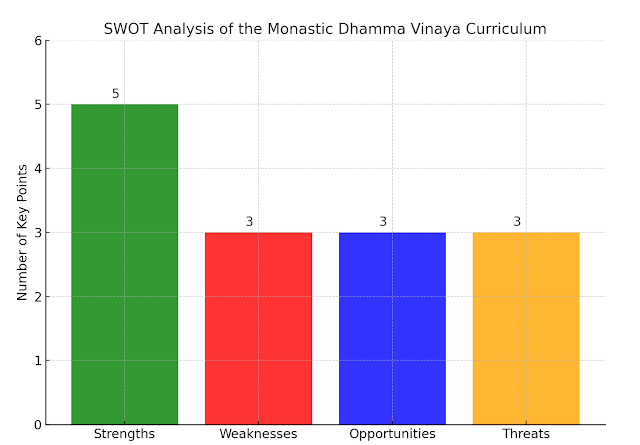SWOT analysis for the Monastic Dhamma Vinaya Curriculum for Monks & Novices:
Strengths
Comprehensive Content:
- The curriculum thoroughly covers ethical, spiritual, and practical aspects of monastic life, including the 75 Sekhiya rules with detailed explanations and applications.
- It integrates both theoretical knowledge and experiential learning, fostering deep understanding.
Structured Approach:
- Clear lesson outlines, objectives, and warm-up activities ensure effective teaching and learning processes.
- Activities like role-playing, reflection writing, and group discussions enhance engagement.
Adaptability:
- The curriculum is designed to be accessible for both seasoned practitioners and novices, with emphasis on mindfulness and discipline applicable in varied settings.
Pedagogical Methods:
- Incorporates VAKT (Visual, Auditory, Kinesthetic, Tactile) methods for diverse learning styles, ensuring inclusivity and retention.
Spiritual Depth:
- Focuses on mindfulness, respect, and ethical conduct, aligning with the core values of Buddhist practice.
Weaknesses
Resource-Intensive:
- Implementation requires trained educators, role-play materials, and sufficient space for group activities.
- Developing reflection journals and tools like reminder cards might demand additional resources.
Complexity for Beginners:
- The depth and detail in some sections may overwhelm novices without prior exposure to monastic rules or mindfulness practices.
Cultural Context:
- Some practices may need localization or adaptation for non-Buddhist or international learners to fully grasp cultural nuances.
Opportunities
Global Reach:
- The curriculum can serve as a valuable resource for international Buddhist communities, academic institutions, and meditation centers.
- It opens avenues for cultural exchange and global dissemination of monastic teachings.
Technology Integration:
- Digital platforms can enhance accessibility, enabling online training programs or interactive e-learning modules.
- Videos, animations, and interactive tools can bring the lessons to life for modern learners.
Interdisciplinary Application:
- Ethical principles and mindfulness practices can appeal to broader audiences, including secular education systems and corporate training programs.
Threats
Resistance to Change:
- Traditional monastic communities may resist modern adaptations or deviations from classical teaching methods.
Language Barriers:
- Translating the curriculum into multiple languages while preserving accuracy and cultural context is challenging.
Sustainability:
- Long-term implementation may face financial or logistical constraints, especially in underfunded regions.




Comments
Post a Comment